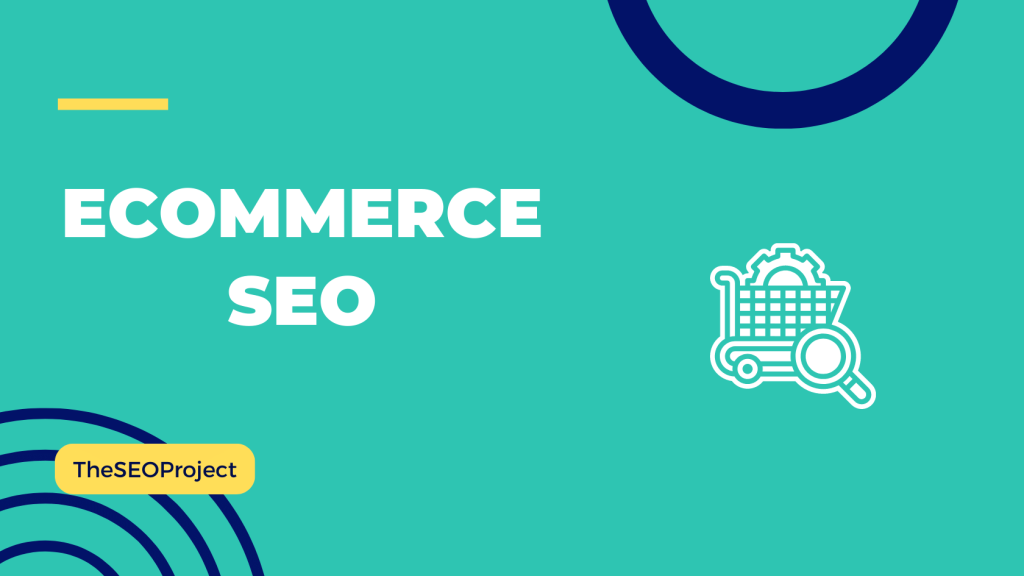Want to know How to do SEO Yourself? Then you are at the right place; hiring an SEO professional can be costly for startups and small businesses, as many charge a minimum of $1000 per month.
Yet, SEO optimization is required for every website.
Many people think SEO is only for professionals; however, knowing the basics can be a significant investment for your website. You will be able to do SEO and reach some goals unless you hire a professional.
Hopefully, we are going to walk you through the main points of DIY SEO so that you be able to do SEO for your website.
You will learn how to start your DIY SEO journey, will find out what factors are important to analyze, and what kinds of professional tools you can use.
At the end of the article, you will get a solid understanding of DIY SEO and how to do it. So, if you are a startup owner or small business owner, this detailed DIY SEO guide is for you.
Firstly, we need to know what SEO is.
What is SEO?
Search Engine Optimization (SEO) is the process in which your website gets optimized in such a way that it is easily found and recognized by bots or search engines, resulting in a better position on Google.
Things to Do Before Starting DIY SEO
First of all, you need to realize that SEO takes time, and you will need to wait weeks or even months to see the results. Patience and consistency are key to achieving success.
1. Know your Target Audience
As a startup owner or small business owner, you will have already defined your buyer persona, and that will help you in the optimization process. It is impossible to do SEO for everyone, as you will not reach your expected goals. Optimize your SEO strategy by utilizing all available information and resources to reach and engage your audience effectively.
2. Set up Search Console & Google Analytics
Use professional tools to make SEO more effective. A big part of SEO strategy is based on data analysis. The Google Search Console and Google Analytics are the required tools to have. Thanks to Search Console, you will monitor your website’s technical performance and search results.
With Google Analytics, you will gain a deeper understanding of your users, their behavior, and their interests. These are the most mandatory and free tools to start your SEO journey.
If you are not comfortable with Google Analytics. Don’t worry! We have listed the best alternatives to Google Analytics.
3. SEO Tools & Extensions to Consider
Apart from the Search Console and Google Analytics, there are tons of professional SEO tools to utilize. The majority of them are paid, and you will get too detailed and valuable information for your strategy. The most famous tools are
- Semrush — 30 Days Free Trial
- Ahrefs
- ScreamingFrog
- Majestic
- Ubersuggest
- Moz
While there are countless SEO tools available, we have highlighted the most popular ones. Although the majority of these tools require a paid subscription, many offer a free version for users to test and evaluate.
Additionally, there are numerous free tools that can assist with SEO efforts and simplify the process. Depending on the tool, the data may differ, so you should choose the one you can trust the most.
For example, SEO professionals and digital marketers prefer Semrush as their favorite professional SEO tool.
When discussing SEO tools, it’s important not to overlook the role of SEO extensions. These are small, specialized tools that can be downloaded as browser extensions and used to aid in the SEO optimization process.
Download the SEO extensions in your browser, get familiar with the SEO tools, and start your optimization.
Tips: How To Do SEO Yourself
Follow the steps below to get started with the DIY SEO of your website.
1. Optimizing Website Elements While DIY SEO
On-site or on-page SEO includes all kinds of optimization that take place on the website in order to improve the website’s rankings.
This includes either optimizing the quality of your website content or monitoring and fixing technical issues. Make your on-site optimization more effective by following Google’s guidelines.
To start your on-site SEO, follow the steps:
1.1 Keyword Research
This is the first step you should take for your on-site optimization. Knowing how many people are interested in your niche will help you optimize your content based on those keywords, which increases your chances of ranking.
However, first, you need to find those good keywords and create content around that keywords. The process requires researching and finding a good keyword which you can do via professional SEO tools like Semrush or Ahrefs or else.
The “Keyword Magic Tool” from Semrush will make your keyword research easy and comprehensive, as you will find descriptions for each metric.
The search volume, keyword difficulty, and keyword intent are the key metrics that you should consider while researching.
- For the search volume – a higher volume is much better.
- For the keyword difficulty – a smaller score is better.
- For the keyword intent – consider informational keywords for blog posts and commercial ones for service pages.
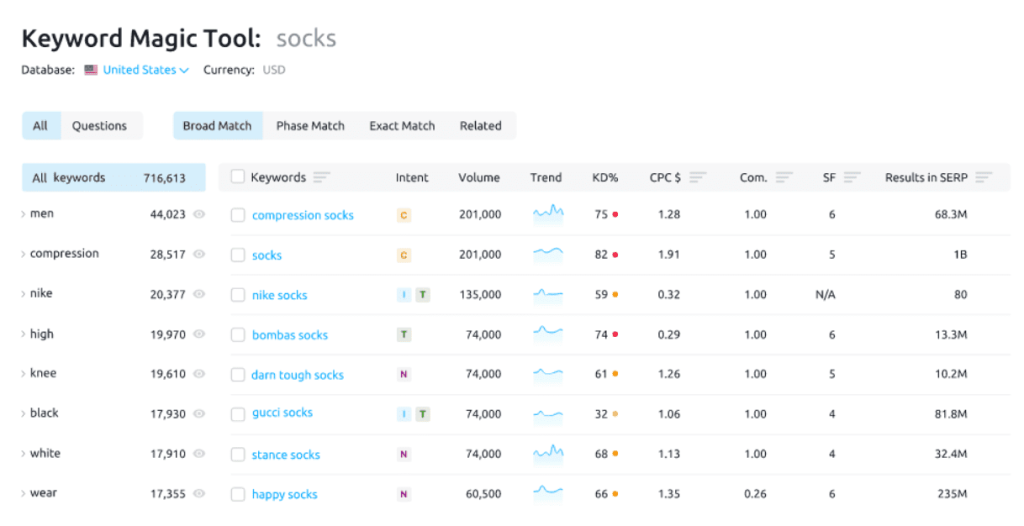
Bonus: Here are some of the best keyword research tool that you can use.
1.2 Content Optimization
To optimize your website’s content for search engines and users, ensure that it is well-structured, easy to navigate, and provides valuable information.
Include relevant keywords that you have found throughout your text, titles, and meta descriptions.
Keep your content high-quality, informative, and up-to-date to increase its authority and relevance in the eyes of search engines.
Remember that you are ultimately writing for people, not only for just search engines, so make sure your content is educational and engaging.
By providing valuable content, you’ll not only improve your search engine visibility, but you’ll also build trust and expertise with your readers, which can lead to more organic traffic and conversions.
By using “Writing Assistant” in Semrush, you will create the desired content. The tool will find some improvement ideas either from the optimization point of view or from the readability part. Optimize and make changes based on the suggestions that the tool can offer.
Pro Tip: Learn how to write SEO-friendly content for better online visibility and engagement.
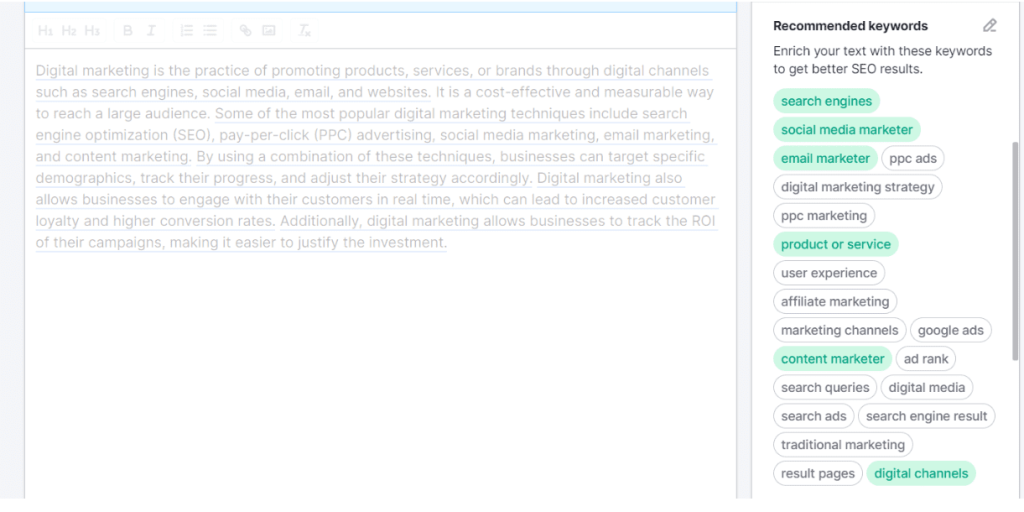
1.3 Title & Meta Description Optimization
As a part of content optimization, title and meta description optimization is another important aspect. Google requires marketers to have them well-optimized and meet its guideline.
Make your titles eye-calling, keep them up to 60 characters, and use the main keyword in them.
Use your copywriting skills to write catchy and Call-to-Action text to have effective meta descriptions, keeping it up to 160 characters. Your keywords should be included in the text, too.
1.4 Internal & External Linking
A good optimization requires reliable external sources. No one will trust your article if you share some statistics without a source. Hence, always use fresh statistics and include the source link in the text.
This is beneficial for user experience and for search engines as you are improving your article’s authority.
Leaning on these facts, always consider using internal and external links in your content as much as possible, and remember that all the links should be contextually natural. Otherwise, there will not be any improvement.
Bonus: Here is an ultimate On-page SEO Checklist to improve your website’s visibility.
2. Competitor Analysis For DIY SEO
Doing an SEO without analyzing competitors is not professional since your competitors are the source of your next idea or the next improvement.
The process requires researching your business niche or SEO competitors and finding opportunities to outrank them. While doing so, pay attention to their ranking keywords, find the content gap and form your next strategy based on your research.
To make your research easier, use Semrush, which offers “Keyword Gap and “Content Gap” features, to help you in this stage.
The “Content gap” tool crawls your and your competitor’s website and gives a list of keywords that your website does not rank.
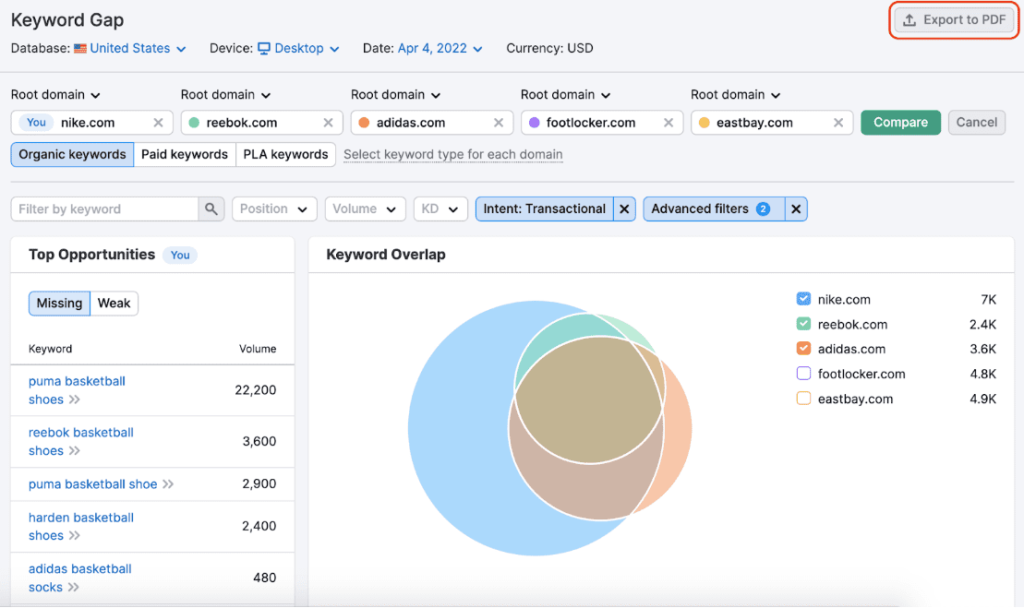
The same applies to the “Keyword gap” tool, but it focuses on wider areas and opportunities to improve your search visibility. Consider those keywords in your upcoming publications.
3. Link Building For DIY SEO
Without high-quality links, your website will get stuck. Off-site SEO is another important part of SEO that helps you increase your brand awareness and promote your business.
Transferring the link equity, the backlinks can skyrocket your rankings and make significant improvements in your performance.
This refers only to backlinks from authoritative websites. To get backlinks, you should conduct an effective link-building strategy. During this time, SEO professionals conducted a number of strategies.
The most common and effective strategy that works well is guest posting. ReferralRock says that 60% of bloggers write one to five guest posts per month.
Did You Know? Links are one of the top criteria in Google’s page ranking algorithm and 22.5% of SEO say the increase in traffic is their main KPI when determining the success of link building. To know such more insights read our article on Link Building Statistics.
Consider these statistics and share educational and informative articles. Show your expertise to the same niche website audiences, and earn a backlink in return.
Google really focuses on the way you earn backlinks. You should be careful not to get featured on low-quality or irrelevant websites.
You can find many relevant opportunities via the Link builder tool in Semrush.
First of all, set up your website in the tool and add 10 keywords that you are going to use for your link-building campaign.
Also, you will need to add 10 competitors to analyze their backlinks. After pressing the “Start link-building” button, the tool will start collecting the opportunities.
Look through them, and connect your email to send your pitches. The tool will help you control the whole link-building process.
4. Technical Health Monitoring
The technical health of the website is no less important than any other component of SEO.
It is also known as Technical SEO and is included in On-Site SEO. Hence, never ignore the technical issue part of your website, as even a slight technical issue can have a bad impact on your website’s performance.
Monitor your technical health occasionally and detect technical issues.
To detect the issues, you need to run a site audit. Site auditor from Semrush will not only assist your DIY SEO but also will give some hints and suggestions to fix the technical issues.
Also, you can use ScreamingFrog. By using the data of these tools, you can easily monitor your website’s technical health. Run your website once a month or two weeks to monitor the technical health.
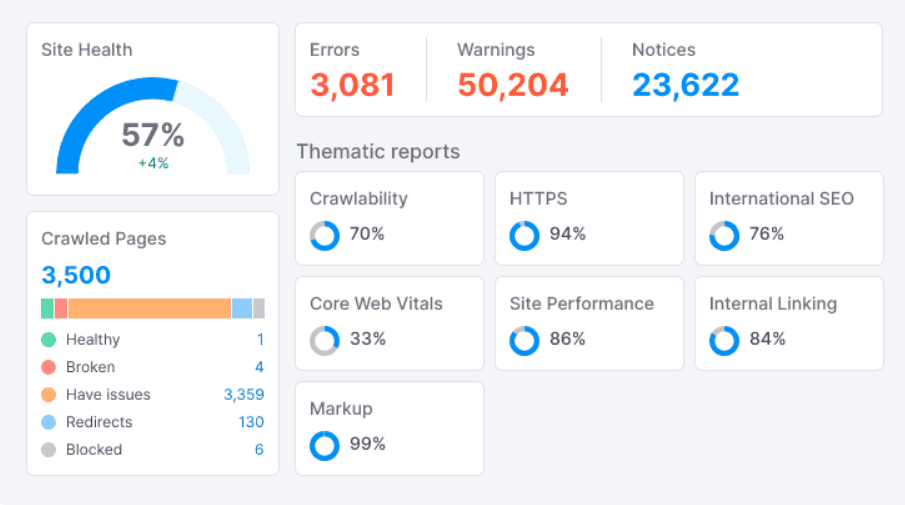
The main points that you need to monitor are:
- 404 pages
- Redirect chains
- Broken links
- Core Web Vitals
- Ref domains
- HTTPS
- Indexability of pages
How to Measure DIY SEO Performance
Your SEO strategy should not always be the same as you should track and analyze everything. Improve or choose another strategy to conduct based on your data. Meanwhile, there are important metrics that you should track:
1. Organic Traffic
This is non-paid traffic that you earn from your rankings when the users click on your page. You can either track the organic traffic with Google Analytics or any other tool like Semrush. The goal of SEO is to improve the visibility of the website in organic search results.
2. Click Through Rate
This is the metric to measure your online performance. A number is calculated by dividing the number of impressions by the number of clicks. This will show the effectiveness of your title and meta descriptions. Use Google Search Console to analyze the data and the trends.
3. Keyword Rankings
Tracking the keywords ranking is crucial and gives the idea — of how the campaign is going. To track your rankings, you had better use the “Position Tracking” in Semrush. You will monitor your rankings easily.
4. Core Web Vitals
These metrics include loading speed, interactivity, and visual stability and are designed to help you understand how well your site is performing for users. Always monitor your website’s loading speed and keep it optimized. As a User experience metric, Google identified this metric as important and included it in the ranking algorithm.
DIY SEO Formula to Scale Niche Websites
Scaling a niche website to attract millions of visitors daily is no small feat, but with the right DIY SEO strategies, it’s entirely achievable. Niche websites thrive on targeted traffic, making SEO an indispensable tool for growth. Here’s a simple yet effective formula to help your niche site reach its full potential.
- Keyword Research with a Niche Focus: Start by identifying long-tail keywords specific to your niche. These keywords often have lower competition but attract highly relevant traffic, which is critical for building authority in your niche.
- Content Optimization and Consistency: High-quality content tailored to your audience’s needs is essential. Ensure every post is optimized for your target keywords and includes relevant media like images and videos to boost engagement.
- Build High-Quality Backlinks: Focus on earning backlinks from reputable sources in your niche. Guest posting, resource link-building, and engaging in community discussions are excellent ways to boost your site’s authority.
- Leverage Social Media and Virality: Niche websites often grow faster by tapping into social media platforms. Sharing engaging, optimized content can drive significant traffic. Use tools to enhance video-sharing capabilities and create viral opportunities.
- Monitor and Adapt: Track your website’s performance using analytics tools. Pay attention to what works and continuously refine your strategies to align with audience preferences and search engine updates.
Related Reads:
DIY SEO is not complicated; optimize your website based on Google’s guidelines, publishing high-quality articles and earning authoritative backlinks.
Combining the effective link-building strategy and monitoring the technical health of your website, you will invest in your SEO performance. Always follow up on the SEO trends, analyze your competitors and improve your SEO strategy by considering new updates and ideas.
You can also take up these SEO courses to boost your DIY SEO game.
FAQs
Yes, definitely. You do not need an SEO expert to optimize your websites. You can easily manage website optimization with an in-house team if you have a start-up, small or medium-sized company.
At the very beginning of your SEO learning stage, you might feel a bit confused and find SEO difficult. But as you learn with the flow, you will find it comfortable.
Here are some of the best DIY SEO tools and software that you can use to make your SEO journey more comfortable.
Ahrefs
Semrush
Keyword Surfer
Surfer SEO
Screaming Frog
